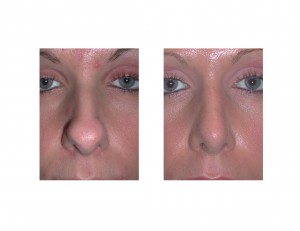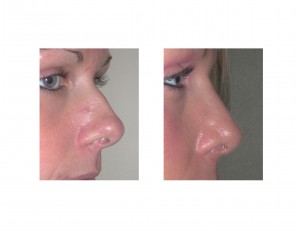Background: The shape of the nose is determined almost exclusively by the size and shape of the underlying framework support of bone and cartilages. The greatest anatomic influence of structure is seen in that of the nasal tip where the lower alar cartilages create a unique shape for each person. The size of these cartilages and how they come together create the form of the nasal tip and the underlying nostril shapes.
The lower alar cartilages of the nose are the most complex of any piece of external nasal anatomy. They are called scroll cartilages because of their shape and they, interestingly, are not really firmly attached to any other nasal structures. Rather they are suspended by numerous small ligaments and soft tissues attachments. As such, when the paired cartilage structures meet in the middle of the nasal tip they actually form more of a spring mechanism. This is why you can push down on your tip and it easily displaces. This is also why the tip of the nose after most rhinoplasties is initially stiff and inflexible as it has been rigidly supported by sutures and cartilage grafts.
Manipulation of the tip cartilages in rhinoplasty is one of the most common and historic rhinoplasty manuevers. Changing the size and shape of the lower alar cartilages to a thinner and more refined tip is a desire of many rhinoplasty patients, particularly those with what is often described as a ‘big’ tip. But the so-called big tip comes in many forms with nearly 10 different variants of nasal tip deformities.
Case Study: This 27 year-old female had long been bothered by what she called a big or fat tip of her nose. She was happy with the rest of her nasal shape. Her tip cartilages were very broad and from a submental view the tip was not shaped like an equilateral triangle but more like a box or a trapezoid.

Her postoperative course was typical for any patient that has had a tip rhinoplasty. The nose was taped for a week and swelling persisted in the tip for months before the final shape began to emerge. At 6 months after her procedure, the final shape of the tip was seen. It took a full year for the tip to become soft and flexible and all feeling to return to it.

Case Highlights:
1) Nasal tip deformities are the result of the size and shape of the lower alar cartilages, also known as the tip cartilages.
2) When the size and width of the tip cartilages exceed the aesthetic dorsal lines of the nose, they are too wide.
3) An open rhinoplasty approach is used to reshape and narrow the tip cartilages for a thinner and more aesthetically pleasing tip shape.
Dr. Barry Eppley
Indianapolis, Indiana


